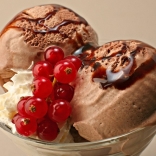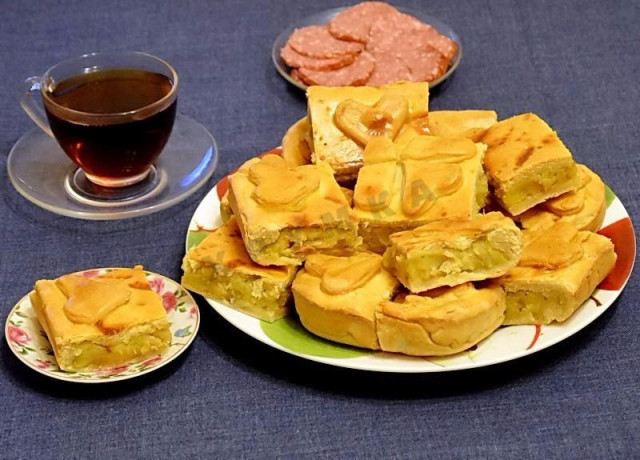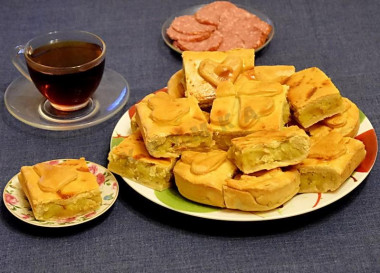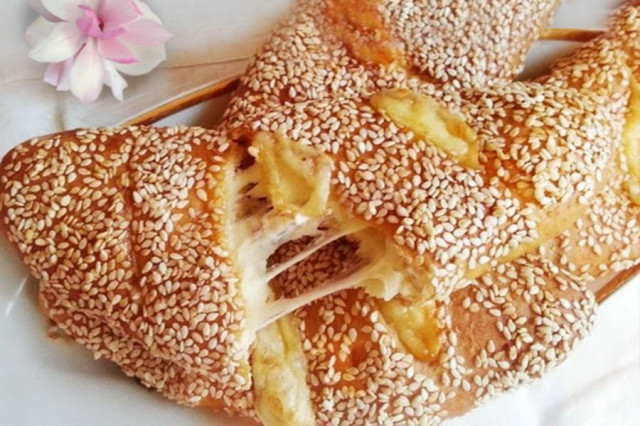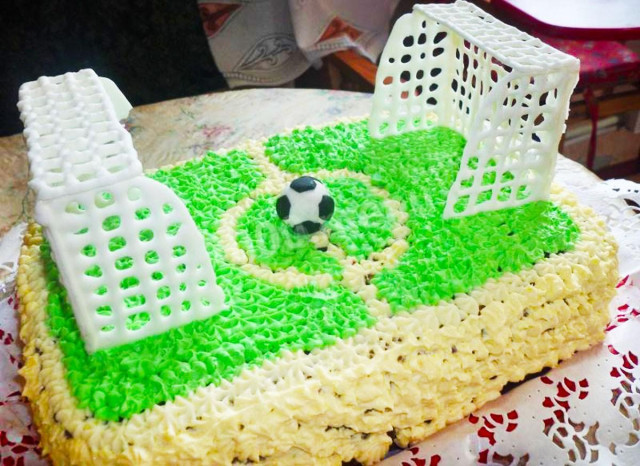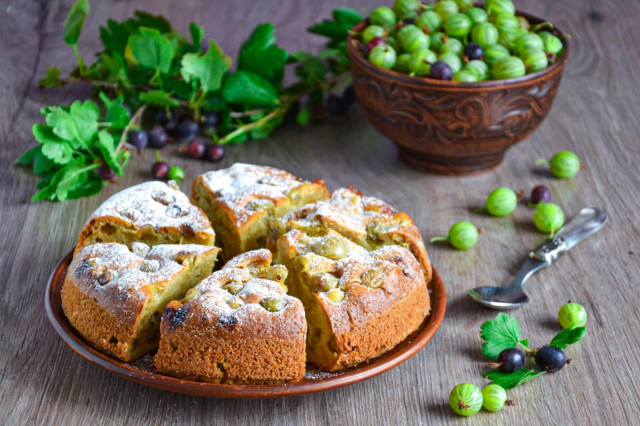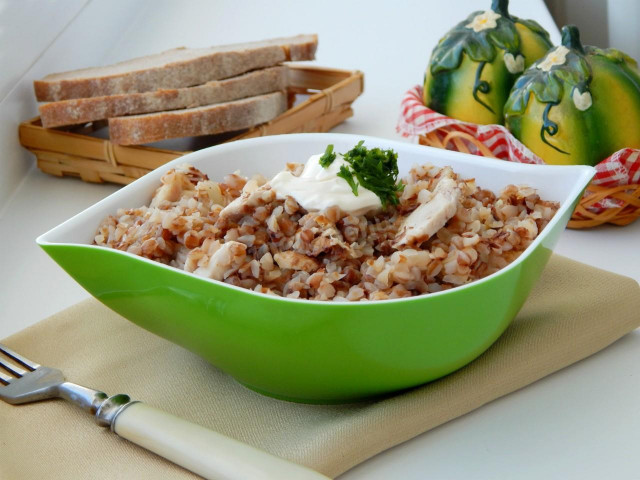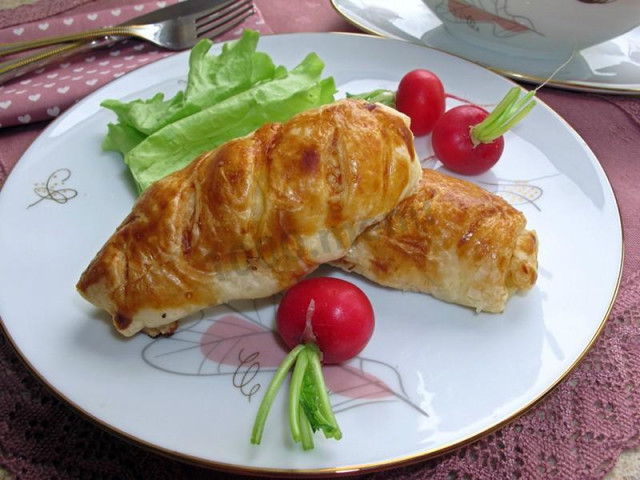Composition / ingredients
Step-by-step cooking
Step 1:
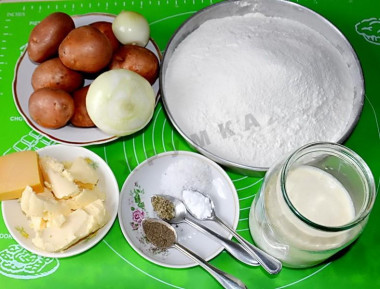
Cake preparation products. The flour has already been sifted. Onion peeled and washed. Potatoes are thoroughly washed with a brush, but not peeled. First of all, we put it to cook in a uniform.
Step 2:
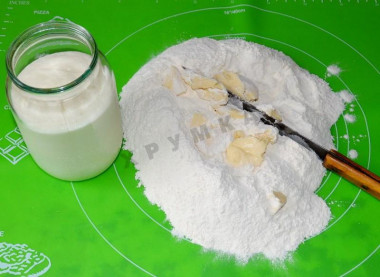
While the potatoes are cooking, we will prepare the dough for the pie. Combine most of the flour and margarine (or butter) cut into pieces. Chop it well with a knife to make a crumb. In kefir, we dissolve salt and soda. This process is accompanied by a violent reaction - the volume of kefir will increase, so we take a spacious dish for it.
Step 3:
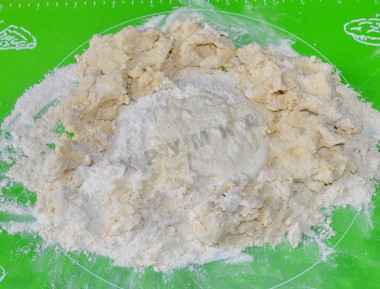
We make a recess on the table in the resulting flour crumbs and pour in the kefir mass in parts, mix everything thoroughly. The dough should absorb all the kefir, so, as necessary, add flour and continue to knead.
Step 4:
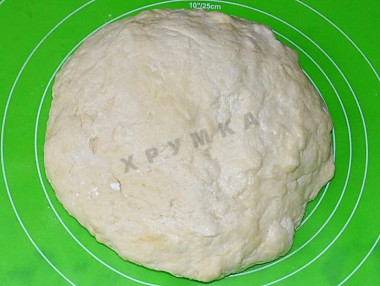
Finally, our dough can be rolled into a bun. If there is not enough flour, you can add it, but not much, otherwise the dough will turn out rough! (I usually, on the contrary, take a little less flour, about half a cup remains for powdering the table when rolling out the dough). While we are doing the filling, the prepared dough can be put in the refrigerator.
Step 5:
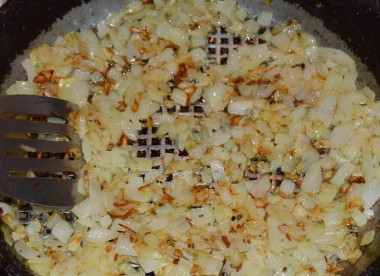
Cut onion into cubes, fry in vegetable oil until ruddy, add oregano at the end.
Step 6:
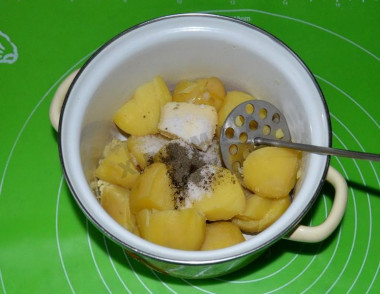
Peel potatoes cooked in a uniform, crush, add a little salt, pepper. Add the fried onion and grated cheese. Mix everything thoroughly. The filling is ready!
Step 7:
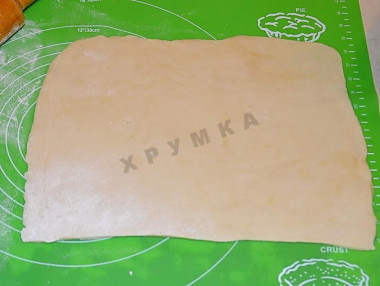
Divide the dough into 2 parts. Roll out each part of the dough with a rolling pin according to the size of the mold or baking sheet. Cut off the extra pieces of dough, combine them into a lump.
Step 8:
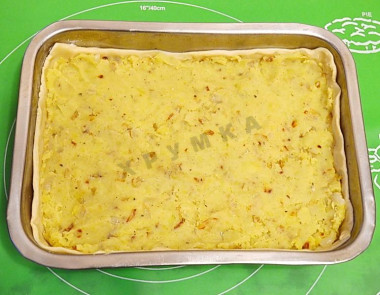
Grease the cake pan with butter or cover it with oiled baking paper. The rolled 1st part of the dough is transferred on a rolling pin directly into the mold. We make low sides and spread the filling. Carefully level out.
Step 9:
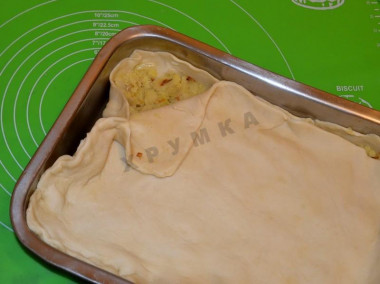
Then cover the filling with the 2nd part of the dough. The edges of the pie are pinched, carefully tuck the resulting seam. We make arbitrary punctures with a fork in the dough over the entire surface of the pie so that there are no ugly, uneven swellings on the finished product.
Step 10:
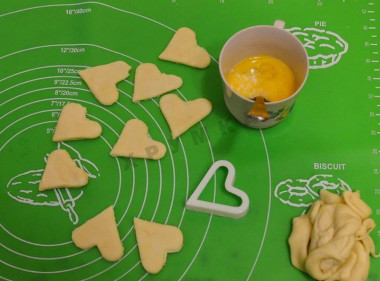
To make the appearance of the cake more beautiful, shake the milk and egg in a cup. Lubricate the pie with this mixture. We roll out a layer of the remaining dough and cut out hearts or others with a cookie cutter.
Step 11:
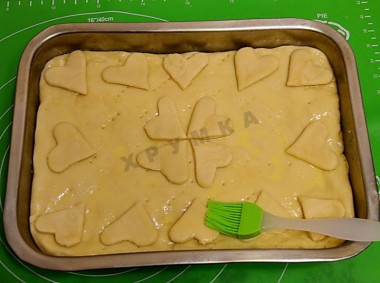
We lay out decorations in any order at our discretion on the surface of the pie and lubricate them with egg-milk mixture. Finally, we send the pie to bake in a preheated 200 degree oven, after 15 minutes. we reduce it to 180 degrees. When the pie is browned, and delicious flavors will float around the kitchen, open the oven door and check its readiness with a toothpick.
Step 12:
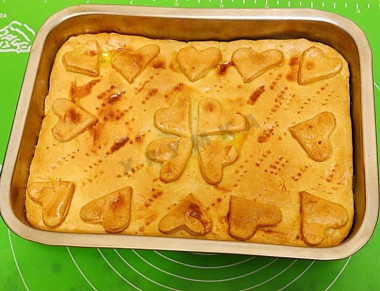
We take the finished pie out of the oven (I had it baked for 40 minutes), cut it, prepare tea, coffee or other drinks, call everyone to the kitchen!
Calorie content of the products possible in the dish
- Ripe potatoes - 80 kcal/100g
- Baked potatoes - 70 kcal/100g
- Mashed potatoes - 380 kcal/100g
- Boiled potatoes - 82 kcal/100g
- Potatoes in uniform - 74 kcal/100g
- Fried potatoes - 192 kcal/100g
- Whole cow's milk - 68 kcal/100g
- Milk 3.5% fat content - 64 kcal/100g
- Milk 3.2% fat content - 60 kcal/100g
- Milk 1.5% fat content - 47 kcal/100g
- Concentrated milk 7.5% fat content - 140 kcal/100g
- Milk 2.5% fat content - 54 kcal/100g
- Chicken egg - 157 kcal/100g
- Egg white - 45 kcal/100g
- Egg powder - 542 kcal/100g
- Egg yolk - 352 kcal/100g
- Ostrich egg - 118 kcal/100g
- Dutch cheese - 352 kcal/100g
- Swiss cheese - 335 kcal/100g
- Russian cheese - 366 kcal/100g
- Kostroma cheese - 345 kcal/100g
- Yaroslavsky cheese - 361 kcal/100g
- Altai cheese 50% fat content - 356 kcal/100g
- Soviet cheese - 400 kcal/100g
- Cheese "steppe" - 362 kcal/100g
- Uglich cheese - 347 kcal/100g
- Poshekhonsky cheese - 350 kcal/100g
- Lambert cheese - 377 kcal/100g
- Appnzeller cheese with 50% fat content - 400 kcal/100g
- Chester cheese with 50% fat content - 363 kcal/100g
- Edamer cheese with 40% fat content - 340 kcal/100g
- Cheese with mushrooms of 50% fat content - 395 kcal/100g
- Emmental cheese with 45% fat content - 420 kcal/100g
- Gouda cheese with 45% fat content - 356 kcal/100g
- Aiadeus cheese - 364 kcal/100g
- Dom blanc cheese (semi-hard) - 360 kcal/100g
- Lo spalmino cheese - 61 kcal/100g
- Cheese "etorki" (sheep, hard) - 401 kcal/100g
- White cheese - 100 kcal/100g
- Fat yellow cheese - 260 kcal/100g
- Altai cheese - 355 kcal/100g
- Kaunas cheese - 355 kcal/100g
- Latvian cheese - 316 kcal/100g
- Limburger cheese - 327 kcal/100g
- Lithuanian cheese - 250 kcal/100g
- Lake cheese - 350 kcal/100g
- Gruyere cheese - 396 kcal/100g
- Dried oregano - 306 kcal/100g
- Oregano - 306 kcal/100g
- Ground black pepper - 255 kcal/100g
- Whole durum wheat flour fortified - 333 kcal/100g
- Whole durum wheat flour, universal - 364 kcal/100g
- Flour krupchatka - 348 kcal/100g
- Flour - 325 kcal/100g
- Kefir fat - 62 kcal/100g
- Kefir of 1% fat content - 38 kcal/100g
- Low-fat kefir - 30 kcal/100g
- Kefir "doctor beefy" 1,8% fat content - 45 kcal/100g
- Kefir 2.5% fat content - 53 kcal/100g
- Butter 82% - 734 kcal/100g
- Amateur unsalted butter - 709 kcal/100g
- Unsalted peasant butter - 661 kcal/100g
- Peasant salted butter - 652 kcal/100g
- Melted butter - 869 kcal/100g
- Table margarine - 720 kcal/100g
- Cream margarine - 720 kcal/100g
- Milk margarine - 743 kcal/100g
- Low-fat margarine - 384 kcal/100g
- Margarine sandwich - 688 kcal/100g
- Margarine for baking - 675 kcal/100g
- Margarine dietary - 366 kcal/100g
- Margarine bold 40 % - 415 kcal/100g
- Margarine - 720 kcal/100g
- Vegetable oil - 873 kcal/100g
- Salt - 0 kcal/100g
- Onion - 41 kcal/100g
- Baking soda - 0 kcal/100g
